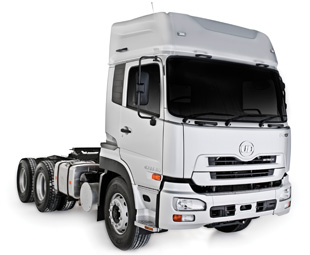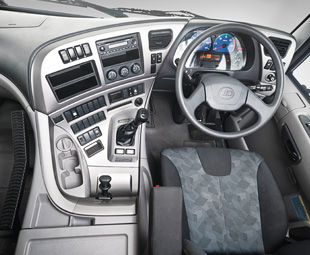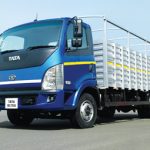Quon-tifying change

UD Trucks has launched the new-generation Quon extra-heavy commercial vehicle range amid its celebration of 50 years in South Africa. As a present to itself, the company couldn’t have done better, reckons GAVIN MYERS
Isn’t it great when things change? An entity that changes and keeps reinventing itself, that doesn’t rest on its laurels and moves with the times to keep advancing, is something to be admired. With clear direction behind the change, it shows courage. It shows progress. Yet, it certainly is strange but true: the more things change, the more they seem to stay the same.
Nowhere has this been more evident than in the case of UD Trucks Southern Africa. This year, the company celebrates 50 years of playing in the South African commercial vehicle market, having gone from strength to strength among periodic changes – the most definitive of which came in 2002 when UD Trucks Southern Africa was formed. It had been known as Nissan Diesel South Africa, but separated from Nissan South Africa to become a full subsidiary of the UD Trucks Corporation in Japan.
The company has grown to the point where South Africa has become the brand’s top market outside of Japan, launching many a legendary vehicle to achieve this status.
Yet another is now being added to the UD Trucks portfolio – the new-generation Quon extra-heavy commercial vehicle (EHCV). Originally launched here in 2008, the company enjoyed a good share of the EHCV market with the Quon prior to the market crash of 2009. Despite having lost a bit of market share at this point – also, by the company’s own admission, due to not having the correct products for the local market – UD Trucks still sees the local EHCV market as an important one to be in in order to be a major player. This time, the new-generation Quon certainly seems the correct product.
For the South African market, 14 new variants are on offer: two 4×2 truck tractors; two 6×4 rigid construction models (one mixer – for now the old model as the new one is still under development – and one tipper); four 6×4 rigid freight carriers; and seven 6×4 truck tractors. The company is also finalising the development of the Allison transmission for the rigid compactor. The product offering has been specialised and refined to meet local market and customer demand, especially in terms of severe heavy-duty applications.
So what exactly has changed? On the surface, the only thing you are likely to notice are the new model nomenclatures. Going back to the naming convention of old, all UD Quon vehicles worldwide will be badged CW (6×4 rigid), GK (4×2 truck tractor) or GW (6×4 truck tractor) – followed by numerals denoting the Gross Vehicle Mass (GVM) and horsepower rating. However, the changes to really shout about are beneath the skin.
 The engine is the GH13 AB Volvo Group engine. This 12,7-litre 6-cylinder turbodiesel unit benefits from some of the latest Group technology and is Euro-3 emission compliant. Available with three power ratings (270 kW at 1 800 r/min and 1 754 Nm at 950 – 1 450 r/min; 300 kW at 1 800 r/min and 2 040 Nm at 1 050 – 1 400 r/min; and 360 kW at 1 800 r/min and 2 448 Nm at 1 050 – 1 400 r/min), the engine has been designed to offer very flat torque curves along with good fuel efficiency. Oil filtration has been improved by employing two-piece full-flow long filters and a one-piece bypass long filter. This has allowed service intervals to be extended from 25 000 to 30 000 km in the long-haul application and from 15 000 to 20 000 km in medium-haul applications, when the company’s branded oil – a special blend designed particularly for this engine – is used.
The engine is the GH13 AB Volvo Group engine. This 12,7-litre 6-cylinder turbodiesel unit benefits from some of the latest Group technology and is Euro-3 emission compliant. Available with three power ratings (270 kW at 1 800 r/min and 1 754 Nm at 950 – 1 450 r/min; 300 kW at 1 800 r/min and 2 040 Nm at 1 050 – 1 400 r/min; and 360 kW at 1 800 r/min and 2 448 Nm at 1 050 – 1 400 r/min), the engine has been designed to offer very flat torque curves along with good fuel efficiency. Oil filtration has been improved by employing two-piece full-flow long filters and a one-piece bypass long filter. This has allowed service intervals to be extended from 25 000 to 30 000 km in the long-haul application and from 15 000 to 20 000 km in medium-haul applications, when the company’s branded oil – a special blend designed particularly for this engine – is used.
The new vehicles also feature the new Extra Engine Brake (EEB), which offers 1 470 Nm of braking torque at 2 300 r/min (Redline is 2 100 r/min). The EEB is designed to utilise both the exhaust and compression strokes of the engine to slow the vehicle down, for safer vehicle control on descents and slippery roads. There is also a retarder fitted that produces over 3 000 Nm torque.
Greater news, though, is the range of transmissions available. On offer are three different fully-syncromeshed manual transmissions – the MTS75D which is the current 7-speed transmission and the MPR90A 9-speed, as well as the new VTO2514B 14-speed group transmission. Big news is the new ATO2612 Group Automated Manual Transmission (AMT). This 12-speed gearbox features the ESCOT V gearshift mechanism and is designed to combine driver comfort and safety, low maintenance and better fuel efficiency. The AMT units feature no less than nine driving modes to ease operation in all conditions.
These gearboxes feature pressurised lubrication via an oil pump, and oil change intervals are every 390 000 km. The AMT and 7- and 9-speed manuals all feature single-plate clutches while twin clutch plates are fitted to the 14-speed manual to offer longer life in the severe operations expected of these models. All have organic clutch linings. There are retarders on all AMT models, with the exception of the 400 hp 4×2 truck tractor.
 Much has also been done to improve the chassis and suspension. The catwalks have been lightened in order to maintain a competitive tare mass while the 5th wheels have been lowered from 1 400 mm to 1 360 mm (1 320 mm on air suspension models). GK models with air-suspension have four bags with height adjustment, so 12R22.5 tyres are fitted on the rear axle. Two bags per axle are fitted on the GK models without height adjustment. The front tyres of the GK, as well as all others across the model range, are 315/80R22.5.
Much has also been done to improve the chassis and suspension. The catwalks have been lightened in order to maintain a competitive tare mass while the 5th wheels have been lowered from 1 400 mm to 1 360 mm (1 320 mm on air suspension models). GK models with air-suspension have four bags with height adjustment, so 12R22.5 tyres are fitted on the rear axle. Two bags per axle are fitted on the GK models without height adjustment. The front tyres of the GK, as well as all others across the model range, are 315/80R22.5.
Mass ratings and drawing tonnages have been increased to improve the versatility of the range (see panel).
All 6×4 truck tractors now have an 800-litre fuel-tank capacity (previously 600 litres) and the freight carriers now have a 400-litre capacity.
All models now feature special off-road chassis packaging, including uprated front axles, heavy duty front suspension and stabiliser bars, radiator protection, as well as repositioned, higher-mounted exhaust silencers and fuel tanks.
The interiors have been upgraded with improved second bunk and storage areas around the cabin. The flagship GW26 490 TT (E14) has luxury items like multi-function display, cruise control, keyless entry and intermittent wiper settings.
So, a lot has changed with the new-generation Quon. Quantifying it, the company’s objective now is to increase its share of the EHCV segment to over 12 percent, even being so ambitious to try achieving 15 percent. Following market trends, the company should achieve this – the new-generation Quon paving the road for the next 50 years.
New-generation Quon – now with Managed Maintenance
UD Trucks Southern Africa has introduced Managed Maintenance on all its new Quon extra-heavy vehicles sold from March 2012. UD Trucks’ Managed Maintenance, an industry first, offers the company’s complete management and overseeing of all repairs and service costs on behalf of its customers.
The company anticipates that the effective control and management of one’s fleet will become more costly and time consuming. In addition, inadequate budgeting and planning often leads to vehicles not being properly maintained, or being sent to non-franchised dealers. This usually results in poor quality work, vehicles breaking down more frequently and, subsequently, a further loss in income.
Managed by UD Trucks Financial Services, Managed Maintenance is a unique monitoring system that controls vehicle maintenance and the repair costs involved on behalf of the customer. The cost of repairs and maintenance is controlled through a detailed scrutineering process, before payment is made to a dealer or supplier on behalf of the customer. This ensures that only justified repairs and maintenance actions will be carried out on the vehicles, while generating numerous reports to assist the customers’ fleet management processes.
As part of the process, the vehicle’s history is checked to ensure the proposed work is necessary and that repairs and maintenance are carried out in accordance with UD Trucks’ specifications and warranties. This way, customers are also able to identify and reduce abuse and misuse of vehicles. In addition, all major repairs require a complete technical report from the dealer, including photos, prior to being authorised. This enables UD Trucks Financial Services to identify recurring faults, failures and so on.
Through the initiative, customers stand to gain a number of cost savings (such as reduced administration costs), while being able to manage their fleets more effectively, make more informed fleet management decisions, and ultimately increase the reliability and life of their vehicles.
Published by
Focus on Transport
focusmagsa



